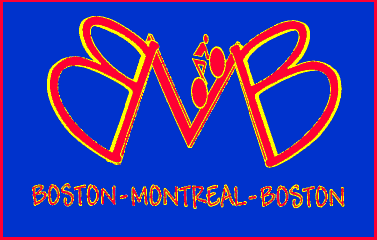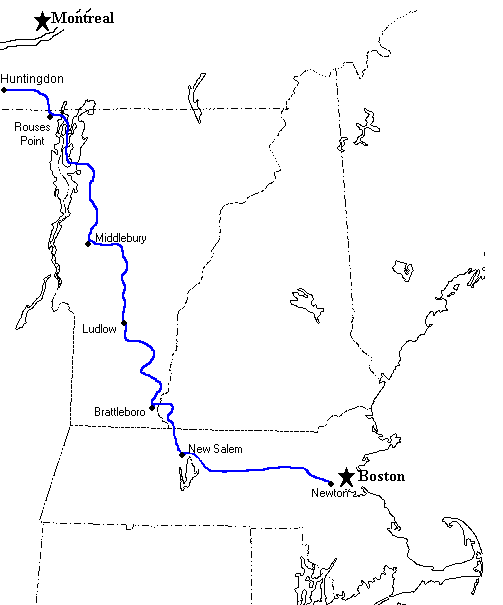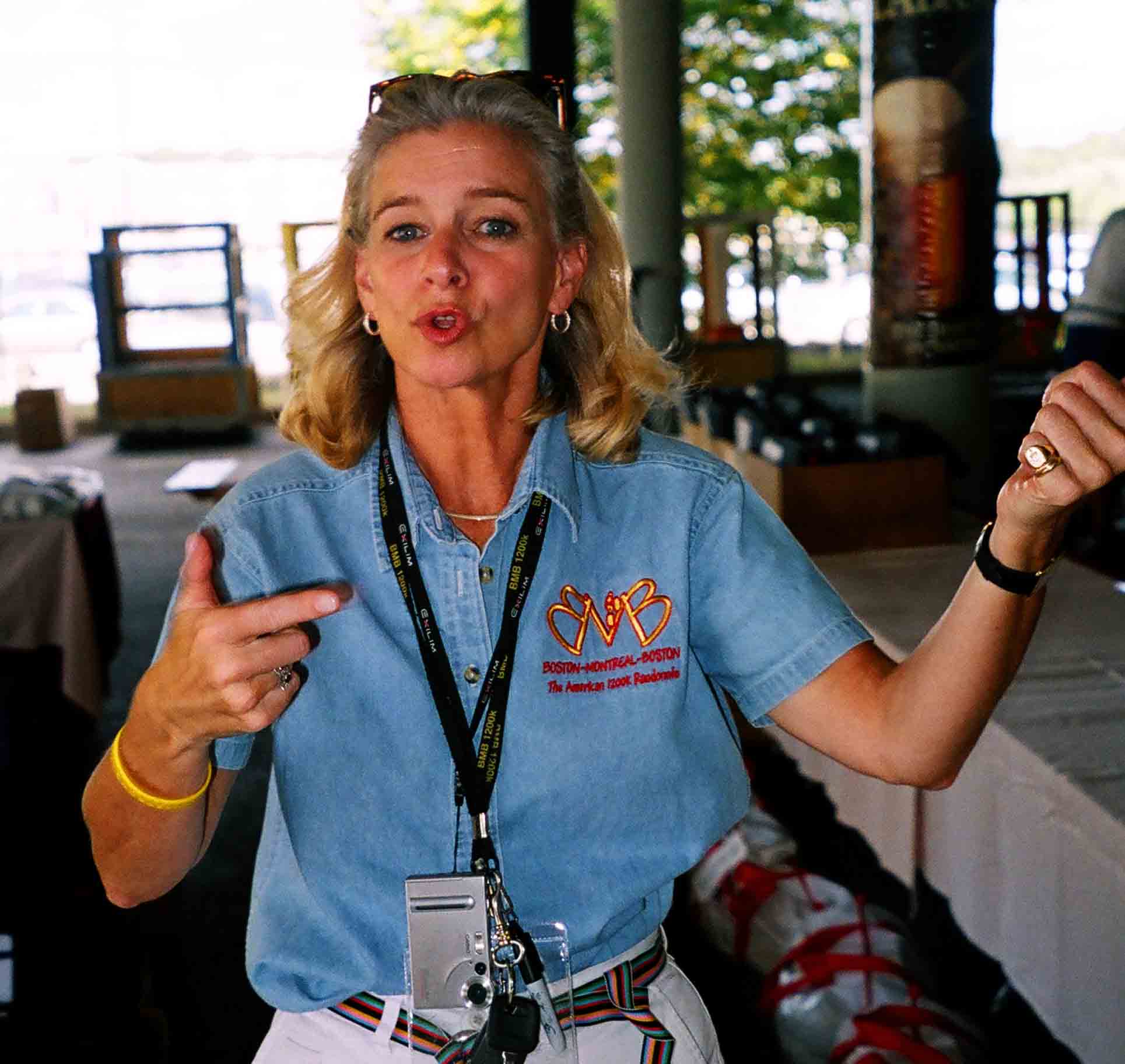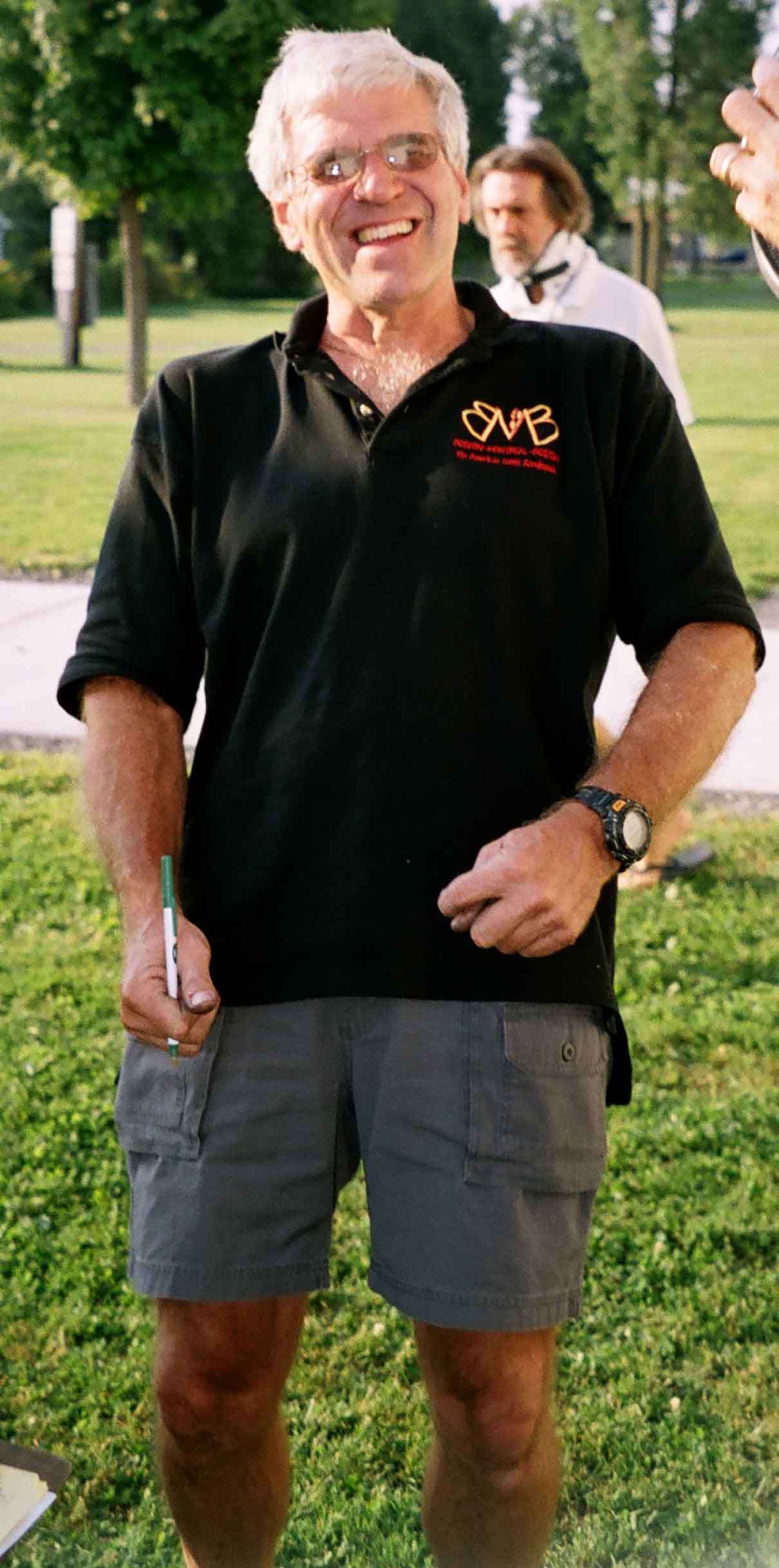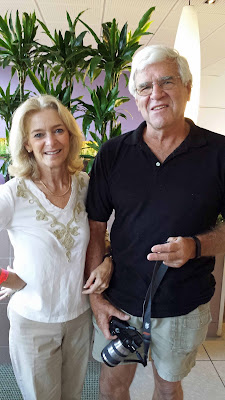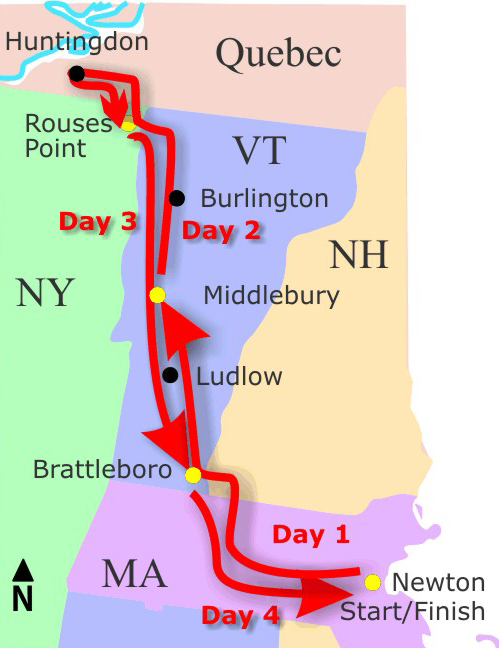|
This historical article on BMB is part of a project by Randonneurs USA to document US grand randonnées. Comments/emendations: records@rusa.org
Boston-Montreal-Boston – offered for the first time in 1988 – was the first grand randonnée (1200 km+) in North America. It was the only 1200k in North America until the Rocky Mountain 1200 in Canada (1996) and the only US 1200k until the Gold Rush Randonnée (2001). BMB was held every non-PBP year from 1988 through 2006 (15 editions). In multiple ways, the iconic US 1200k. Comparisons with PBP - BMB was held in mid-August, the same time of year as Paris-Brest-Paris. BMB had more climbing than PBP, and the climbs were tougher, especially in Vermont. The route was more rustic (except near the turnaround point in Quebec on the original route). Highest point on the BMB route is near Ludlow VT and Terrible Mountain (2219 ft. (676 m)), followed by Middlebury Gap (2,144 ft (653 m)). Highest point on the PBP route is at Roc Trevezel (1,260 ft (384 m)). Origins – In 1988, Charlie Lamb and Hauke Kite-Powell – veterans of PBP’87 – put together an event modeled as the American counterpart to PBP and later tagged “The American Randonnée.” Living in the Greater Boston area, they routed BMB from Newton, Mass., a western Boston suburb, into Quebec near Montreal. Canadian Ted Milner got to know Charlie and Hauke when all three were at MIT. Ted writes: "I helped them plan the first Boston-Montreal-Boston 1200 km randonnee. I knew the south shore roads quite well and planned the route from the U.S. border to Saint-Lambert, which became the turn-around point for the BMB." Charlie pre-rode the entire BMB route, and said afterwards he should have brought lower gearing. The inaugural BMB had 19 starters. Original Route – The original start/finish was at a school, and proceeded at the 4:00 am start onto a path through a golf course with speed bumps. The original route then took Rte. 20 west of the Boston metro area and then Hwy. 119 across southern New Hampshire, then northbound west of the Connecticut River on Rte. 100 in Vermont to the first overnight in Middlebury, after climbing Middlebury Gap. The second stage visited Lake Champlain via South Hero Island and North Hero Island on the way to Rouses Point, NY, and into flat, open terrain in Quebec. Turnaround point was in St. Laurent, QC, across the river from and in sight of Montréal. The approach into St. Lambert was urban and suburban. Rouses Point, about a mile from the US-Canadian border, was the second overnight, and the third was at the youth hostel in Ludlow, VT. Departing Ludlow, riders immediately faced the Mt. Terrible climb – possibly the stiffest climb of the route. That was one of a pair of attention-getting climbs in Vermont, the other being Andover Ridge. The final day took riders past Walden Pond in Concord, Mass., and on into the finish. Sleeping arrangements were cots in gymnasiums in Middlebury and Rouses Point, and bunk beds in Ludlow. BMB’88 was hot, with highs in the 90’s. One rider, Jeff Vogel, skipped sleeping in the (unairconditioned) Ludlow hostel because of the heat, and continued on through the night. The third overnight was later changed to a motel in Brattleboro, VT, offering more comfortable sleeping for riders. Riders were responsible for booking their own rooms. This shortened the final stage to about 113 miles, while making the third stage longer but not overly long. Jennifer Wise and Pierce Gafgen – In 1993, Jennifer Wise and Pierce Gafgen took over as BMB's organizers, and put on 11 editions. Jennifer and Pierce had been involved with Race Across AMerica (RAAM), and Jennifer would go on to serve as president of Les Randonneurs Mondiaux, founding member and first president of Randonneurs USA, and RUSA’s representative to Audax Club Parisien. Later Routes – Start/finish was changed to the Holiday Inn in Newton, on the Rte. 128 loop. Half of the ground-level parking, while still open to the outdoors, was sheltered by the hotel above it, making it convenient to use for the start and for the buffet dinner at the finish. Routes headed more directly west into hilly Central Massachusetts – through Princeton and up the steep hill to Barre – with a checkpoint at New Salem, MA, and only a small incursion into New Hampshire, but featuring the route's only covered bridge. The overnights continued to be Middlebury, VT, Rouses Point NY, and Brattleboro VT. The turnaround in Quebec was changed to the small town of Huntingdon, QC, at the town’s Canadian Legion (veterans hall) post. Local volunteers graciously staffed this checkpoint. This made for a very quiet, rustic route, although hillier. Arrowing – BMB routes were arrowed in white paint on the pavement. Given the winding nature of New England roads, with many forks and turns, this was a boon to riders in those pre-GPS days. We know of no other US 1200k with course arrowing, but BMB did model PBP, which uses arrow signs to this day. 1000k + 200k Option – Riders could ride the same course with the same support and overnights but as an ACP 1000k brevet, finishing in Brattleboro, plus an (optional) ACP 200k brevet back to the finish. The main purpose of this option was to provide 1000k credit for riders seeking the ACP Randonneur 5000 award. Similar options have since been adopted by some other US Grand Randonnées over the years. Quad Centuries – The Quad Centuries was a parallel event held concurrently with BMB. The four centuries, over four successive days, roughly followed the first and last 200 miles of the BMB route. First and third overnights were in Brattleboro. The second overnight was in Middlebury. Multiple Starting Times – BMB’s main starting time was 4:00 am, but in some editions, a 10:00 am starting time was also offered, intended for faster riders. 10am starters had 84 hours to finish, like the 84-hour option at PBP. Can-Am Challenge– In 1997, Jennifer Wise (president of Les Randonneurs Mondiaux) and Réal Préfontaine (VP) concocted a challenge to see if anyone could ride both North American 1200k’s – BMB in the US and the Rocky Mountain 1200 in Canada – in a single season. Dr. Préfontaine succeeded at that first challenge, and it is still a RUSA/Canadian award today. RAAM Qualifier – For some years in the early 2000’s, riders who declared their intention to try to qualify for the Race Across America (RAAM) using BMB and who finished in under 65 hours became qualified to ride RAAM. This was a RAAM policy for all 1200k’s who agreed to be part of this option. Several BMB riders did qualify this way. They are listed on the BMB website. John Marino Competition – BMB was included as an event in the UltraMarathon Cycling Association’s John Marino Competition, where riders’ finishing times earned them points in that year-long competition. Those riders adhered to the same rules as all other BMB riders, including rules for personal support. BMB Permanent - In 2009, Susan Plonsky, a multi-time veteran of BMB and the RBA of the AZ: Casa Grande region, created a RUSA Permanent route and the idea for a RUSA Permanent version of BMB. In 2011, Susan publicized a this perm route plus a combination of rides, including two 1200k two route options, a five-day Free Route Permanent option, a six-day route option, and Quad Century routes. Her original BMB perm route has been ridden a number of times over the years, as shown via Search for Results. ResourcesResults - Results for all BMB 1200k events, and for BMB 1000k and 200k brevets in the RUSA era, are available on the RUSA website. Results are also available via the Internet Archive on the BMB archived websites. These also contain Quad Century results and lists of RAAM qualified riders. Pre-RUSA BMB 1200k Results (1988-1998) on RUSA Website RUSA-Era BMB 1200k, 1000k, and 200k Results on RUSA website - Go to Search for Results and filter by Region = "MA: Boston-Montreal-Boston" - the special RUSA region created to organize BMB events. Route - The 2002 BMB route is now available: BMB 2002 route in a RideWithGPS Collection - thanks to Jim Howell and Brett Sterling for constructing these RWGPS routes based on the 2002 cue sheet. This allows you to explore the elevation and climbing grades in detail, plus the scenery via Google StreetView. Thanks to Mark Thomas for providing the Excel cue sheet. BMB Website - The BMB website was hosted in two successive locations on Geocities.com. Geocities no longer exists, but the websites have been archived by the Internet Archive's Wayback Machine. Geocities "Colosseum/2570" index in Internet Archive Geocities "b-m-b" index in Internet Archive You can browse these indices for captures of BMB home pages and drill down through links on those pages for rules, cue sheets, results, and general event info. A couple of examples: Photos Courtesy of Jonathan Abitbol, President of the Montréal/Québec Club
CREATED: 7-MAR-2023 - JLE
|
|

